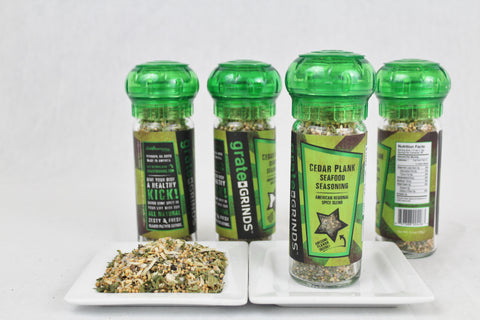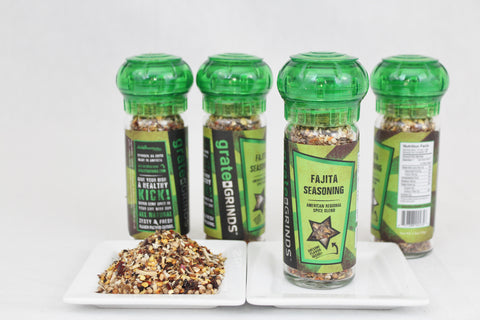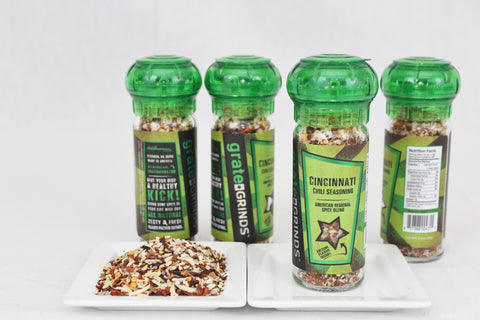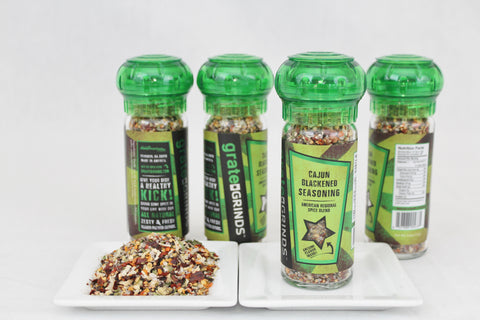Roast Chicken Seasoning
Roast Chicken Seasoning - This is a classic rotisserie chicken blend of herbs and spices. Grind this all over your chicken, or under the skin for better flavor, before roasting or grilling. The aroma while this is roasting is so genuinely sole fulfilling.
Share this Product
Roast Chicken Seasoning - This is a classic rotisserie chicken blend of herbs and spices. Grind this all over your chicken, or under the skin for better flavor, before roasting or grilling. The aroma while this is roasting is so genuinely sole fulfilling.
Spice Ingredients: Pacific sea salt, black pepper, garlic, onion, celery, sugar, New Mexican chile flakes, mustard seeds, lemon zest, crushed red pepper, sage, rosemary, oregano and thyme.
Please click on the RECIPE tab here for detailed cooking instructions.
Roast Turkey Seasoning is available in a 4 oz. spice grinder bottle filled with 2.4 oz. of Roast Chicken Seasoning.
Roast Chicken Seasoning Cooking Instructions
NOTE: To review meats you wish to use, please refer to the "Recommendation Guide to selecting your beef, pork, chicken, turkey or seafood" PDF, located in the Recipe link in the heading at the top of the Home page.
Whole Chicken Preparation:
There are two ways to cook a whole chicken. Either leave it whole or butterfly it. The advantage to butterflying your chicken (or any poultry) is to speed up the cooking process while cooking a “bone-in” bird, which will be moister than boneless breasts or thighs, alone. If you have time and want to present the whole roast bird on the table, then leave it whole and roast or barbecue it.
There are two ways, we know, to butterfly a whole chicken. One is what we call the American ways and the second is what we call the Latin way. We will describe both ways below. Different countries butcher meats differently than we do in the US.
American way to butterfly a whole chicken: Figures 1 thru 4

Figure 1. With the breast side down, cut down one side of the backbone, starting at the neck bone (shown). Use a sharp serrated or stiff boning knife, because you need to cut through the rib bones and the leg/hip ball joint

Figure 2. Then cut down the other side of the backbone to remove it.

Figure 3. Remove the backbone and save for chicken stock or discard.

Figure 4. Turn the chicken over and spread it apart.
Latin way to butterfly a whole chicken:Figures 5 thru 7

Figure 5. Press the leg/thigh apart from he breast and cut the skin between them. Continue to separate the leg/thigh and breast and cut down to the ball joint, but don't cut through it. Do the same on both sides of the leg/thigh and breasts.

Figure 6. Cut through the rib bones down to the neck bone on both sides. Then press the breasts back flat.

Figure 7. Turn the chicken over and press down to finish flattening out the chicken.
General Cooking Instructions:
1) To use the Grate Grinds Roast Chicken Seasoning, evenly spray or rub a little oil on all sides of your chicken thigh, breast or whole chicken. Then grind the seasoning evenly on all sides of your chicken, gently pressing it onto the surface. Try to get some of the seasoning under the skin, by separating the skin from the meat with your fingers gently. (Figure 9, below) Grind some of the spice mix into a small plate or bowl. Use a spoon or your fingers and spread the spice mix under the skin as evenly as you can.
2) The amount of rub you grind on is up to your flavor preference. The more rub you grind on your chicken, the more of a flavor impact the seasoning will have. Figures 8 thru 11, below, are examples of how much seasoning to grind onto your chicken, as a general rule. The process is the same for each cut of chicken, it's really only the cooking times that change.
NOTE: One word of caution, these rubs are self-contained, meaning that they already have salt in them in the proper ratio to the spices and herbs, so don’t overdo it with grinding the rubs or add any additional salt.

Figure 8. Butterflied chicken with Roast Chicken Seasoning.

Figure 9. Adding some Roast Chicken Seasoning between the skin and meat.

Figure 10. Whole seasoned chicken in a roasting pan.

Figure 11. Whole chicken on a bed of mirepoix (classic mixture of 50% onion, 25% carrot and 25% celery).
3) After you have seasoned and rubbed your chicken, refrigerate it and allow your seasoning to rest on the meat for at least 20 minutes or up to twenty-four hours.
NOTE: Always buy your meats from a quality reputable stores. Keep all meat under refrigeration as much as possible during preparation. Don’t leave any meats out at room temperature for more than 30 minutes, except when you are ready to cook it. Then let it just reach room temperature prior to cooking, but don’t let time exceed an hour. Food safe guidelines recommend that any proteins (meats in this case) are not exposed to the “Temperature Danger Zone” (40 F. to 140 F) for more than 4 hours for its entire journey to you cooking it. We are informing you of these food safety guidelines, because we want you to have a wonderful flavorful safe food experience, every time.
Now at this point you could "barbecue", smoke/grill roast or oven roast your chicken. Below are cooking instructions for both. A word of advice, you can cook your chicken at 400 F., but in the end you will dry out your chicken or any other meat. The slower and lower the temperature (to a point) you cook your chicken the more tender and juicy it will be. The high heat, literally evaporates the juices inside the meat.
Barbecuing your chicken in a smoker
- Preheat your smoker to 250-275° F. Place your seasoned chicken away from the direct heat source or the smoke box. Check and rotate your chicken every hour for even cooking/smoking. Cooking time depends on the temperature inside your smoker and size of the chicken you are smoking. Remember to resupply your smoking medium as necessary to maintain the smoker temperature. You must smoke roast your chicken to an internal temperature of 165° F. for food safety reasons. Check the temperature in the thickest part of the breast or thigh. We highly recommend that you use a remote oven thermometer, see Figure 12, below, for some samples. Set the alarm to 165° F, so you don't over cook it.

Figure 12. Different brands of remote cooking thermometers.
Grill or oven roasting your chicken
1) Preheat your gas grill/oven or allow the barbecue coals to turn hot white to 400°F. to 425°F. so the chicken will rapidly sear, sealing in the juices caused by this initial high heat process. (Note: keep the grill cover/lid closed)
2) Once up to the preheat temperature, place your seasoned chicken in a roasting pan on the grill, to protect it from the high heat. Optionally you can place your chicken on a bed or mirepoix (a mixture of 50% onion, 25% carrot, 25% celery chopped). The use of a roasting pan is to protect the chicken from the direct high heat, which will burn the chicken over the long cooking times. Searing the chicken should take around 15 to 20 minutes, depending on the size of your chicken and the type and temperature of your grill or oven.
3) After your chicken has a nice light brown crust, turn down the oven heat, gas or adjust the coals to maintain the heat at around 275°F to 300ºF. Now, your job is NOT to touch the chicken or open the lid/cover too often. Have a beer or soda, mow the lawn, rake leaves or watch some football or baseball. The time it takes to "barbecue" or grill roast a whole chicken. The time it takes depends completely on the temperature of the grill/oven and the size of the chicken you are using. Check the internal temperature in the thickest part of the breast ot thigh. We highly recommend that you use a remote oven thermometer, see Figure 12 above, for some samples. Set the alarm to 165° F, so you don't over cook it. We don't recommend stuffing a chicken when cooking at these lower gentle cooking times as the stuffing might not cook in the proper length of time to achieve 165°F. required USDA internal temperature for a poultry product AND it will take a longer time than the times listed in the chart below for cooking at 325° F. You can obviously increase the temperature to speed up the cooking time, but be careful or you will dry out your chicken.
Approximate grill/oven roasting cooking times for various types of whole and cuts of chicken at 325ºF.
| Type of Chicken | 1 1/2 to 3 pounds | 3 to 4 pounds | 5 to 7 pounds | 4 to 6 ounces | 6 to 8 ounces |
| Chicken | 45 to 75 min. | ||||
| WholeBroiler/Fryer | 75 to 90 min. | ||||
| Whole Roaster | 1 1/2 to 3 hours | ||||
| Chicken breast - bone in | 10 to 15 min. per side | ||||
| Chicken breast - boneless | 8 to 10 min. per side | 10 to 15 min. per side | |||
| Chicken leg - bone in | 10 to 15 min. per side |
ALL COOKING METHODS:
Once your chicken has reached 165ºF, remove it from the smoker, grill or oven and let it "rest" under a foil tent (a piece of foil, completely covering the chicken. There is an activity that takes place now called “carryover cooking”. Once your food is removed from the heat source, it will continue to cook for 5 to 10 minutes for smaller cuts, 15 to 20 minutes for larger cuts of meat. The retained heat in the meat continues the cooking process for a few more minutes, as the meat cools down. Part of this resting period is to also allow the internal liquids in the meat, which are forced to the center by the intense cooking heat, to redistribute themselves back throughout the meat, before you slice it. If you are too impatient, those wonderful flavorful juices will end up on your cutting board instead inside your chicken.

Figure 13. Whole roasted butterflied chicken.

Figure 14. Whole butterflied grilled chicken.

Figure 15. Whole roasted chicken.
 PROUDLY MADE IN AMERICA
PROUDLY MADE IN AMERICA









